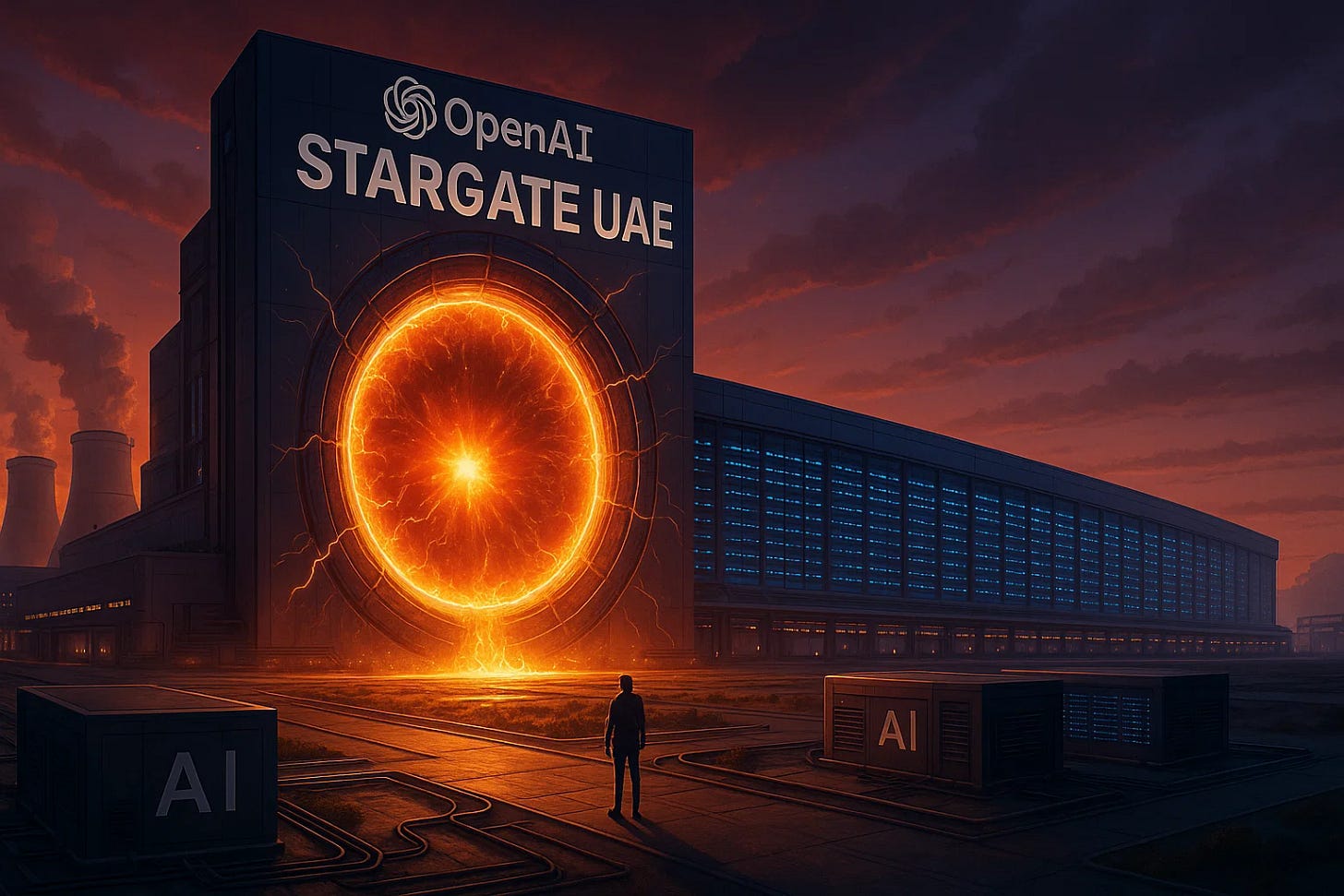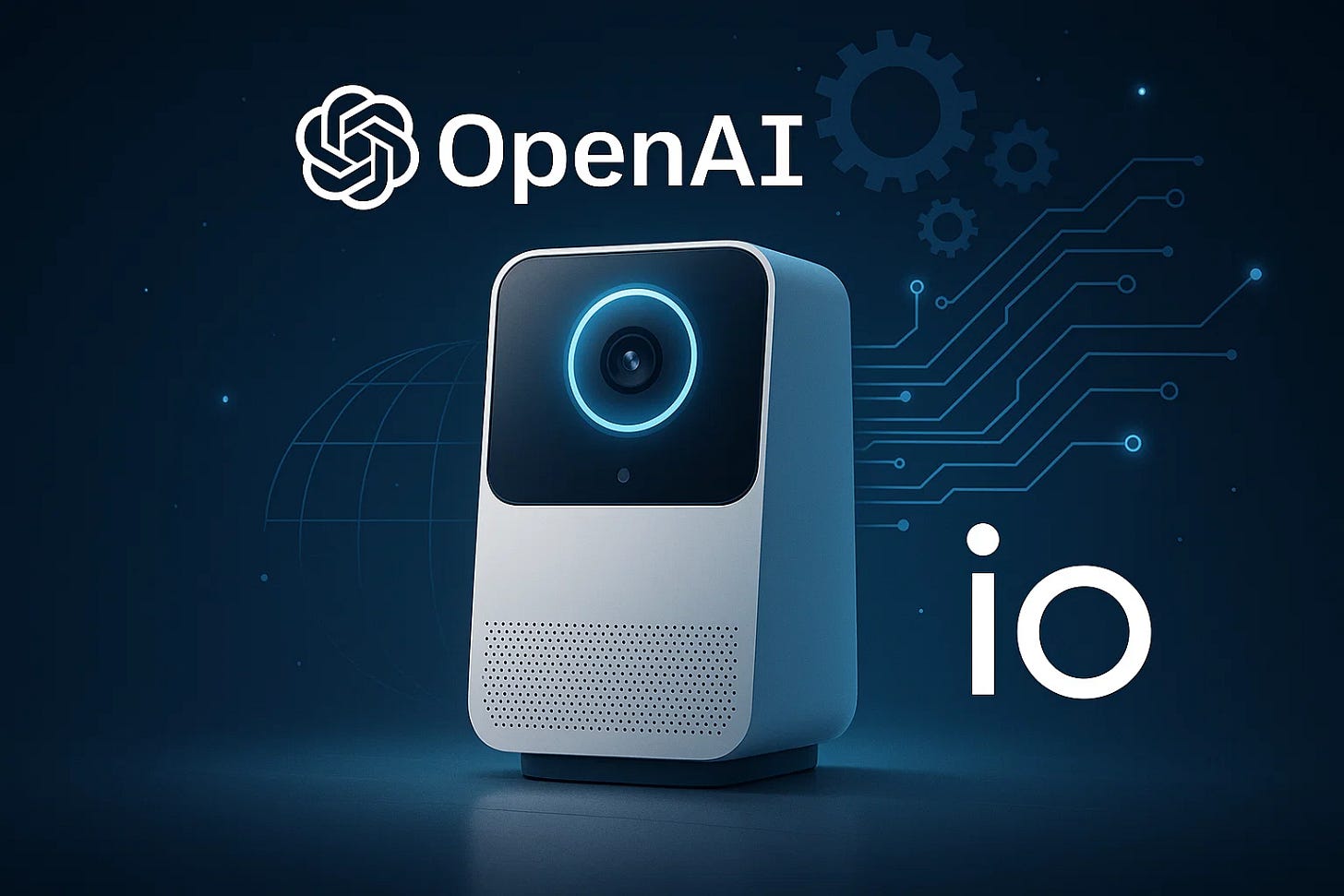AI Compute Arms Race: OpenAI’s 1 GW UAE Gigafactory, $6.5 B Jony Ive Coup & NVIDIA’s 800 V Power Surge
Welcome, AI & Semiconductor Investors,
OpenAI just unveiled the colossal 1 GW "Stargate UAE,". Simultaneously, NVIDIA kicked off an electrifying revolution, shifting data-center power infrastructure from 54 volts to a stunning 800 volts, catapulting Navitas Semiconductor’s stock by over 120%. Meanwhile, OpenAI’s unexpected $6.5 billion acquisition of Jony Ive’s hardware studio signals that AI isn't just coming—it’s about to reshape our daily lives through groundbreaking devices.— Let’s Chip In
What The Chip Happened?
💻 “Stargate UAE” Launches a Gigawatt AI Super-Compute Footprint
🔋 Navitas Joins NVIDIA’s 800 V Data-Center Revolution
⚙️ Hardware Ambitions: OpenAI’s $6.5B Bet on Jony Ive’s io
[Navitas Q1 2025 Earnings: GaN and SiC Propel Next-Gen Power]
Read time: 7 minutes
Get 15% OFF Finchat — MY FAVORITE STOCK MARKET DATA PLATFORM
OpenAI (Private), Nvidia (NVDA), Oracle (ORCL), Cisco (CSCO)
🔥 “Stargate UAE” Launches a Gigawatt AI Super-Compute Footprint
What The Chip: On May 22, 2025, OpenAI unveiled “Stargate UAE,” a massive 1 GW data-center campus near Abu Dhabi. Slated to go live in phases starting in 2026, the site will power advanced AI models at frontier scale. As a sweetener, every UAE resident will receive complimentary ChatGPT Plus access.
The Situation Explained:
🚀 Scale & Purpose: Stargate UAE is designed for large-model training and inference on a 1 GW scale—about four times bigger than the original Stargate in Texas.
☀️ Location Advantage: Low-cost solar power, proximity to Africa and South Asia, plus the UAE’s “free-zone” data-localization rules make this site strategic for global AI expansion.
💻 Hardware Stack: OpenAI will deploy NVIDIA’s next-gen Grace-Blackwell GB300 accelerators, integrated with Oracle Cloud Infrastructure (OCI) and secured by Cisco zero-trust networking.
🤝 Key Players: G42 (Abu Dhabi) handles financing and development. Oracle supplies on-prem hardware bundles. Cisco delivers AI-optimized switching and security. SoftBank Vision Fund 3 provides minority equity. Microsoft has an indirect stake via existing OpenAI equity.
🏗️ A Repeatable Template: OpenAI calls Stargate a “gigafactory for compute,” exporting a standardized blueprint to sovereign partners under its new “OpenAI for Countries” program.
⏳ Timeline & Funding Hints: The first 200 MW of capacity will go live in 2026. Meanwhile, the original U.S. Stargate in Texas continues to expand toward 1.2 GW by 2028 but faces tariff-related funding delays.
“We’re excited to bring our blueprint to global partners,” said OpenAI CEO Sam Altman. “Stargate UAE demonstrates how we can co-develop local AI ecosystems with robust safety oversight.”
Why AI/Semiconductor Investors Should Care: Stargate UAE signals an escalating arms race in AI compute, with enormous demand for next-gen chips, high-bandwidth networking, and specialized cloud infrastructure. NVIDIA’s GB300 accelerators and Oracle’s AI cloud fabric could see multi-year tailwinds from such sovereign-scale deployments. By franchising its data-center template to well-capitalized nations, OpenAI shows how quickly the global AI market is evolving, and how deeply compute capacity now shapes geopolitical and investment dynamics.
Get 15% OFF Finchat — MY FAVORITE STOCK MARKET DATA PLATFORM
Navitas Semiconductor (NASDAQ: NVTS)
🚀 Navitas Joins NVIDIA’s 800 V Data-Center Revolution
What The Chip: Navitas Semiconductor’s stock rocketed over 120% intraday after announcing a co-development agreement with NVIDIA for an 800-volt high-voltage direct-current (HVDC) power-delivery platform. The goal is to power next-generation AI data centers more efficiently, transitioning from today’s 48–54 V bus bars to an 800 V infrastructure that can handle 1 MW-plus “AI factory” racks.
The Situation Explained:
🔋 Big Voltage Shift – NVIDIA wants to convert 13.8 kV utility power straight to 800 V DC at data-center entrances, then step down to board-level voltages with minimal energy loss. This approach should slash copper usage by ~45% and reduce power loss by ~5 percentage points, cutting operating and capital expenses.
⚙️ Navitas’ Secret Sauce – Navitas brings its GaNFast™ gallium-nitride and GeneSiC™ silicon-carbide power devices, plus a new “IntelliWeave” digital-control platform that has already hit 99%+ efficiency in lab tests. Tinier, faster-switching FETs let racks stay air-cooled, even at 1 MW of power.
💰 Future Revenue Model – Although no immediate payments are disclosed, Navitas will provide reference designs and custom modules qualified to NVIDIA specs. Once production ramps for Kyber-generation servers in late 2026/2027, Navitas will likely sell power ICs and modules directly to NVIDIA’s power-supply and ODM partners, analysts say it’s a “multi-hundred-million-dollar TAM” over the platform’s lifecycle.
♻️ Greener AI – “We are aiming for up to 20% total-facility energy savings,” says NVIDIA, highlighting how HVDC distribution cuts energy losses and shrinks the data center carbon footprint, important as regulators and tariffs tighten around emissions.
🤝 Multiple Partners – Infineon, Monolithic Power, ROHM, STMicroelectronics, and Texas Instruments are also on NVIDIA’s 800 V vendor list, plus power giants Eaton, Schneider Electric, and Vertiv at the facility level. NVIDIA wants to ensure multiple qualified sources rather than a single-supplier risk.
📈 Why the Rally? – This is Navitas’ highest-profile design-win to date. While real revenue from shipments is a few years away, the endorsement from NVIDIA signals broad potential for Navitas’ GaN/SiC in server and electric-vehicle markets.
Why AI/Semiconductor Investors Should Care: This milestone underscores the growing importance of power efficiency in AI data centers, when racks can draw up to 1 MW, cutting a few percentage points of loss becomes a massive cost and carbon saver. With NVIDIA openly collaborating across multiple suppliers, the wide-band-gap (GaN/SiC) ecosystem looks primed for long-term growth. For investors, this development highlights how solving the power bottleneck can generate meaningful returns alongside the core AI chip market, especially as demand for more power-dense computing accelerates.
OpenAI (Private)
⚙️ Hardware Ambitions: OpenAI’s $6.5B Bet on Jony Ive’s io
What The Chip: On May 22, 2025, OpenAI announced it will acquire io, a hardware studio spun out of Jony Ive’s LoveFrom. With a $6.5 billion stock-heavy deal, OpenAI aims to fuse Apple-like industrial design with its AI tech. This bold move could reshape how we interact with AI through specialized devices.
The Situation Explained:
🤝 The Acquisition: OpenAI issues ≈ $5B in stock at closing, plus $1.5B in performance equity for io’s 55 employees. Jony Ive becomes Chief Creative Officer-at-Large for OpenAI, while LoveFrom remains independent on retainer.
💡 Ready-Made Hardware: io brings two prototypes—an AI lapel pin that uses bone-conduction audio and a laser projector, plus a “desk companion” that’s always-listening. “We believe that hardware is the next frontier for immersive AI experiences,” said OpenAI CEO Sam Altman.
✍️ Design DNA: Jony Ive and ex-Apple hardware leads now direct both physical and software design for ChatGPT. “We’re excited to fuse design and AI in entirely new ways,” said Ive.
💰 New Revenue Lever: By using mostly stock, OpenAI preserves cash while aiming for a multi-billion device market. Sam Altman estimated “100 million units in the first wave alone.”
🔜 Timeline & Price: Pending regulatory approval by Q3 2025, the first product could launch in late 2025 at $699–$799, bundled with a “ChatGPT Plus Pro” subscription.
🛠️ Supply Chain Boost: Constantly-listening AI devices need specialized chips, audio, and camera modules, which are potential wins for semiconductor and EMS (electronics manufacturing services) suppliers.
⚠️ Risks to Watch: Consumer adoption is not guaranteed. Humane’s AI Pin struggled. Also, regulators may scrutinize device-based data collection and export controls.
Why AI/Semiconductor Investors Should Care: This acquisition could spark a brand-new AI hardware category if consumers embrace it. Microsoft (which holds a major stake in OpenAI) stands to benefit through consolidated hardware sales and heavier cloud usage. If successful, component makers and specialty chip companies could see volume gains from always-on AI gadgets. However, hardware margins are typically razor-thin, and competition from Apple, Google, and Meta may quickly heat up. This is the next step in AI’s race to reach everyday consumers, and it has the potential to expand the AI market beyond software subscriptions alone.
Youtube Channel - Jose Najarro Stocks
X Account - @_Josenajarro
Get 15% OFF Finchat — MY FAVORITE STOCK MARKET DATA PLATFORM
Disclaimer: This article is intended for educational and informational purposes only and should not be construed as investment advice. Always conduct your own research and consult with a qualified financial advisor before making any investment decisions.
The overview above provides key insights every investor should know, but subscribing to the premium tier unlocks deeper analysis to support your Semiconductor, AI, and Software journey. Behind the paywall, you’ll gain access to in-depth breakdowns of earnings reports, keynotes, and investor conferences across semiconductor, AI, and software companies. With multiple deep dives published weekly, it’s the ultimate resource for staying ahead in the market. Support the newsletter and elevate your investing expertise—subscribe today!
[Paid Subscribers] Navitas Q1 2025 Earnings: GaN and SiC Propel Next-Gen Power
Date of Event: May 5, 2025
Executive Summary
*Reminder: We do not talk about valuations, just an analysis of the earnings/conferences
Navitas Semiconductor Corporation (NASDAQ: NVTS), a pure-play innovator in gallium nitride (GaN) and silicon carbide (SiC) power semiconductors, held its first-quarter 2025 earnings call on May 5, 2025. President, CEO, and Co-Founder Gene Sheridan and Chief Financial Officer (CFO) Todd Glickman presented the quarterly performance, highlighting steady progress despite near-term market softness.
Navitas reported Q1 2025 revenues of $14 million, near the midpoint of prior guidance and down from $23.2 million in Q1 2024. Gross margin (on a non-GAAP basis) landed at approximately 38.1%, while non-GAAP operating expenses declined to $17.2 million, illustrating the company’s focus on cost discipline. Management emphasized the impacts of inventory adjustments in solar, electric vehicle (EV), and industrial markets.
At the same time, Navitas touted important new product qualifications and technology milestones:
GaN Bidirectional Switches (BDS) for solar microinverters, EV onboard chargers, and other applications
GaNSafe technology achieves automotive-grade qualification
GeneSiC new ultra-high-voltage silicon carbide (up to 2.3 kV and potentially above 6.5 kV), aimed at commercial EV, renewable energy, and energy storage
Notable management comments underlined the continued transition from GaN’s strong foothold in mobile phone fast-charging to higher-power segments such as data centers and EV power electronics. Sheridan cited design wins worth $450 million in lifetime revenue potential, expecting stronger results to materialize in late 2025 into 2026.
Growth Opportunities
Navitas plans to expand in four key areas:
AI Data Centers – Demand for advanced chips is fueling increased power needs, with new server architectures requiring higher wattage power supplies. Navitas’ GaN and SiC devices aim to enable more efficient, high-density power designs.




